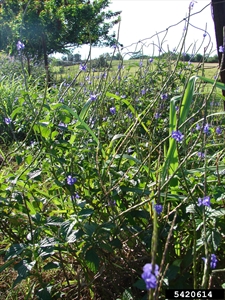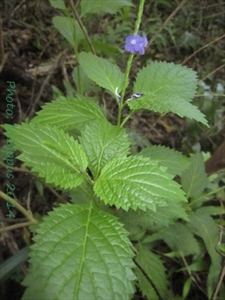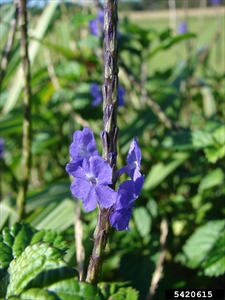- Widespread. Asia, Africa, North, South and Central America, Caribbean, Oceania. In many Pacific islands.
- Invasive weed of plantations, pastures, grasslands, forests and forest margins, secondary fallows, sand dunes, waste areas, and roadsides. Threatens natural vegetation. Aggressiveness because large seed production (7000 from one plant). Produces chemicals inhibiting growth of competitors.
- Perennial shrub, 1-1.5 m tall. Stems, greenish with purple, becoming round and woody. Leaves, oval, 5-8 cm long, opposite along stems, with saw-like margins. Flowers, dark blue, purple or violet, about 1 cm across, on spikes, up to 45 cm long, at top of stems, without stalks. Flowers, with five petals forming tube, with two stamens. Spikes become woody. Fruits develop within cavities. Seeds brown/black.
- Spread: seeds, fur of animals; clothing; machinery; use as an ornamental;
- Biosecurity: as an ornamental; contaminant of pasture seed; among 10 worst weeds in American Samoa, French Polynesia, Solomon Islands.
- Biocontrol: little known.
- Cultural control: hand weed; do not overgraze; slash and apply herbicide; improve pastures with recommended grasses and legumes; vehicle hygiene.
- Chemical control: in Australia: slash or mow plants, wait for regrowth, then apply glyphosate (and Fiji); 2,4-D; fluroxypyr; dicamba.
Pacific Pests, Pathogens and Weeds - Online edition
Pacific Pests, Pathogens, Weeds & Pesticides
Rat's tail (457)
Blue rat's tail; it is also known as dark blue snakeweed. CABI prefers the name rattail.
Stachytarpheta urticifolia. It is a member of Verbenaceae.
There are a number of other Stachytaropheta species: Stachytaropheta cayennensis, Stachytarpheta indica, and Stachytaropheta jamaicensis. There has been considerable confusion and misidentifications between these. Some authorities think that Stachytarpheta urticifolia is the same as Stachytarpheta cayennensis, while others prefer to keep them separate - the flowers of Stachytaropheta cayennensis are pale blue to white.
AUTHORS Grahame Jackson, Aradhana Deesh & Mani Mua
Adapted from Dark blue snakeweed (Stachytarpheta cayennensis) (2018) Weeds of SE Qld and Northern NSW. Lucidcentral. (https://www.lucidcentral.org/editors-pick-animal-and-plant-identification-keys/key-to-weeds-of-se-qld-and-northern-nsw); and additional information from CABI (2019) Stachytarpheta urticifolia (rattail). Invasive Species Compendium. (https://www.cabi.org/isc/datasheet/117323); Waterhouse DF, Norris KR (1987) Stachytarpheta urticifolia. Biological Control Pacific Prospects. Inkata Press, Melbourne; and Stachytarpheta cayennensis (2019) Wikipedia. (https://en.wikipedia.org/wiki/Stachytarpheta_cayennensis); and from Snakeweed Stachytarpheta spp. (2020) Queensland Government. (https://www.daf.qld.gov.au/__data/assets/pdf_file/0005/54392/snakeweed.pdf). Photos 1&3 Forest & Kim Starr, Starr Environmental. Photo 2. Tonton Bernado. Stachytarpheta urticifolia (Verbenaceae).
Produced with support from the Australian Centre for International Agricultural Research under project HORT/2016/185: Responding to emerging pest and disease threats to horticulture in the Pacific islands, implemented by the University of Queensland, in association with the Pacific Community and Koronivia Research Station, Ministry of Agriculture, Fiji.






